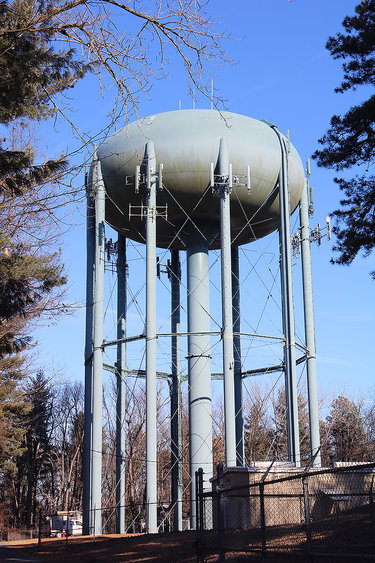Guilderland makes plans to reduce TTHM levels in drinking water
The Enterprise — Michael Koff
All of the water towers in Guilderland, including the Westmere tower, shown here, will get “gentle mixers” to help agitate the water and prevent the growth of algae, according to Timothy McIntyre, the town’s superintendent of water. The first to get a mixer will be the Fort Hunter tower.
GUILDERLAND — Disinfectant added to Guilderland’s drinking water to keep it safe has caused summertime spikes of a chemical that could be dangerous.
Like other municipalities, Guilderland chlorinates its drinking water to kill viruses and bacteria. But the chlorine reacts with naturally occurring organic matter in the water, producing byproducts of trihalomethanes and haloacetic acids, which have demonstrated carcinogenic activity in laboratory animals, according to the federal Environmental Protection Agency.
Therefore, the EPA sets standards for acceptable amounts of these byproducts in drinking water.
This week, customers in Guilderland’s water district, both homes and businesses, received a letter from Timothy McIntyre, the town’s superintendent of water, stating that the average levels of total trihalomethanes, known as TTHMs, in the town’s water have been higher, over the last four quarters sampled, than the contamination limit set by the EPA and by the state’s Department of Health. The notice was also sent out to email subscribers and posted on the town’s website. EPA officials could not be reached because of the government shutdown.
Guilderland had a similar problem with byproducts at the turn of the century, which town leaders thought had been solved by looping water lines and installing a purification system — projects which together cost over $6 million.
The water in the western part of the town comes more predominantly from the Watervliet Reservoir, while Westmere and McKownville have more water from other sources, including wells and Albany water, town Supervisor Peter Barber said Tuesday.
The running average for TTHMs over the four quarters of 2018 in Guilderland was 83.5 micrograms per liter, which is the same as 83.5 parts per billion, while the contamination limit is 80.
Testing in Guilderland for haloacetic acids show numbers below the federal and state limit of 60 parts per billion in recent years. In 2015, the average for reservoir water after it was treated in the plant was 43.4; in 2016, it was 48.2; in 2017, it was 58.5.
The figures were above 80 in just one of the four sampling sites in the town, McIntyre said. Testing is done in McKownville, near McKown Road; at the Westmere water tank; at Serafini Drive, off East Old State Road; and on Terry Avenue, off West Lydius Street.
Only the Terry Avenue site had the high numbers, McIntyre said.
Neither McIntyre nor Barber could provide The Enterprise with the actual figures for 2018.
Dr. Thomas Brady, assistant director of Environmental Health Services at the Albany County Department of Health, said that in August the figure at the Terry Avenue site was 125 micrograms per liter, and that the figure at that same site was “80-something” in November. It was the November figure, Brady said, that pushed the average of the four most recent quarters over 80.
“It’s unusual,” he said, “because normally in November you’d be seeing 60s or 70s.”
Brady said he would provide written figures with a request under the state’s Freedom of Information Law, which The Enterprise filed on Wednesday.
If the average at one sampling site is over the limit, state regulations say that the water district must issue a notice, Brady said. “Used to be they’d average all four sites, but the regulations have gotten stricter,” he said.
Guilderland’s water plant uses activated carbon to remove a certain percentage, Brady said, adding, “They’re going to use more of that going forward. So we don’t expect to see this again.”
Brady said he has received some calls from concerned residents. “It’s not extremely high; 83.5 is above, but not enormously above,” he said. But, Brady went on, residents had a right to ask questions and express concern.
Guilderland is, Brady said, taking appropriate steps to make sure this doesn’t happen again.
He noted that the next testing will be done in February.
Solutions
Guilderland is considering a multi-pronged approach, McIntyre said. This includes better filtering at the water plant, churning machines in the Watervliet Reservoir, similar mixers in the town’s water towers, and diversifying Guilderland’s water supply — for example, getting water from Rotterdam, which uses wells.
McIntyre said of the water plant, “We have granulated activated carbon filtration, in line with our filters, that helps. We’re going to do some studies with our engineering, to see if we can tweak that.”
Changes are planned for the town’s water towers, beginning with Fort Hunter, McIntyre said. This would involve “total reconditioning, as well as adding a mechanical mixer within the tanks that would help break that cycle.”
He said, “You’ve got to think, you’ve got the heat of summer beating on the tank.”
The longer water sits in storage, the more susceptible it becomes to TTHMs, if there are still any organics in it, McIntyre said.
The water inside the water towers is now mixed, to some extent, when water is added or taken out, McIntyre said, but “we feel it is not enough turnover.
“It’s in the works now, to go out to bid for tower work,” he said, adding that he hopes for the work on the Fort Hunter tower to be complete by the end of 2019. He said he hopes that the total reconditioning, which involves resurfacing and painting inside and out “hopefully gives us another 50 years.”
The Fort Hunter tower will get a mixer first. The tower in Westmere will be next, and the one on Relyea Road between Voorheesville and Guilderland, near Weatherfield, will eventually get one, McIntyre said, adding, “We want to work on our most prevalent and controlling towers first.”
The town is also in the midst of setting up an interconnect with the town of Rotterdam, McIntyre said, adding that this will give the town “a little more leeway in terms of getting water that comes finished.” Guilderland will not need to treat the water it gets from Rotterdam, McIntyre said.
Barber and McIntyre discussed the water-quality issue at a town board meeting Tuesday night. Barber said that the water from Rotterdam is from wells and not from a reservoir. He said, “I don’t think this will ever recur, once we have this set up.”
The town’s water supply comes not only from the reservoir but also from wells and from the city of Albany, Barber said. He added that diversifying the water supply with non-reservoir sources helps.
Total trihalomethanes are produced only when chlorine interacts with organic material, he continued. “And that only happens at the reservoir.”
McIntyre said that the only quarter that exceeded the EPA and state limits for TTHMs was in the summer. The town of Watervliet, which owns the reservoir located in Guilderland that supplies both Guilderland’s and Watervliet’s water, is preparing to go out to bid to buy equipment to help resolve the issue, which McIntyre explained is related to sunlight and photosynthesis and algae blooms.
Watervliet is planning to buy “giant mixers” that will be placed strategically around the reservoir, McIntyre said.
“They’re able to turn over a lot of water,” McIntyre said. “The algae isn’t able to bloom.”
That equipment would make it possible to control the water before it gets to the point where chemicals are needed, he said. The machines will circulate the warmer, top layer of water to disrupt the proliferation of bacteria.
The equipment acts as an aeration system and increases the levels of dissolved oxygen in the water, said Jeremy Smith, general manager of the city Watervliet. The higher the levels, the better, he said, adding that the city is putting together a bid spec that includes four mixers.
Smith said that Watervliet has regulations to protect the reservoir from agricultural or industrial activity around it as well as from road salt and runoff, but the problem is enforcement. “The management of the streams that get into the reservoir involves multiple municipalities across three counties,” he said.
The problem is watershed management and originates with the runoff that goes into the streams, Smith said. “That’s what we’re battling on a regular basis.”
Most of the lands around the reservoir are privately owned but, when any of them become available, Watervliet looks into whether there is a way for the city to buy them, Smith said.
McIntyre’s letter
TTHMs include four chemicals: chloroform, bromoform, bromodichloromethane, and dibromochloromethane.
McIntyre’s letter, which echoes language from the EPA, says, “The amount of TTHMs formed in drinking water during disinfection can change from day to day, depending on temperature, the amount of organic material in the reservoir, the amount of chlorine added, and a variety of other factors.”
Disinfection of drinking water by chlorination kills bacteria and viruses that could cause serious illnesses, the letter says, adding that chlorine is the most commonly used disinfectant in water supplies in New York State and that all public-water supply systems that use a surface-water source with chlorine for disinfection contain TTHMs to some degree.
The letter states: “Some studies suggest that people who drank water containing very high levels of TTHMs over the course of 20 to 30 years may have an increased risk of certain health effects including the risk for cancer and low birth weights, miscarriages and birth defects. However, these studies could not rule out the role of other factors that could have resulted in the observed increased risks and other similar studies do not show an increased risk for these health effects. Some animal studies with very high exposure show that some TTHMs may increase risks for these health effects, but the exposure in these studies was much greater than could result from the normal use of drinking water.”
The U.S. EPA concluded that, while there was “no causal relationship” between disinfection byproducts including TTHMs and human health effects, stronger regulations were warranted, to limit the amount of TTHMs in drinking water, while allowing for adequate disinfection.
The risks from TTHMs are very small compared to the risks for waterborne illnesses such as cholera, dysentery, typhoid and other ailments that come from drinking water that is not adequately disinfected.
The letter to town residents states, “At present, the water is suitable to drink, cook with and bathe in.”
It adds, “Although we do not consider the following measures necessary to avoid health effects, you may use water pitchers containing an activated carbon filter or install a tap-mounted activated carbon filter for water.”
Asked if he uses any filters at his own house, McIntyre told The Enterprise, “I drink it straight out of the tap.”
Defining dangers
The World Health Organization classes both chloroform and BDCM, or bromodichloromethane, as “possible human carcinogens,” on the basis of research on animals that, the organization states, “may or may not be relevant to human cancer.”
The other two chemicals in TTHMs, which the World Health Organization lists as bromoform and dibromochloromethane, are “not classifiable,” which WHO says means there is no evidence to say that they are carcinogens, and not enough research to classify them as non-carcinogenic.
The second edition of its guidelines on TTHMs states, “Where local circumstances require that a choice must be made between meeting either microbiological guidelines or guidelines for disinfectants or disinfectant by-products, the microbiological quality must always take precedence, and where necessary, a chemical guideline value can be adopted corresponding to a higher level of risk. Efficient disinfection must never be compromised.”
The hazards of inadequately disinfected water are “real and more immediate” than the effects of TTHMs, according to the Centers for Disease Control and Prevention, which calls TTHMs “certainly the lesser of these two evils.”
Diarrheal disease in the developing world is still a leading cause of death among infants and children under 5, according to the Centers for Disease Control, which adds that, in these populations, the risk of death or delayed development in early childhood from diarrheal disease transmitted by contaminated water is far greater than the relatively small risk of cancer in old age.
When water contains TTHMs, ingesting it may not be the primary danger. The Centers for Disease Control states, “In populations who take hot showers or baths, inhalation and dermal absorption in the shower accounts for more exposure to TTHMs than drinking water.”
A page about TTHMs on the website of the government of Manitoba, Canada says, “Exposure from a 10-minute shower or 30-minute bath is about the same as drinking two and a half litres of cold water.”
According to an article on the website of the National Institutes of Health, researchers studied a small number of subjects in two communities, in North Carolina and Texas, with the North Carolina site having a water supply with a higher level of trihalomethanes than the one in Texas. The study found that showering and bathing are “important sources of TTHM exposure,” and that washing dishes by hand and “being exposed to a cohabitant’s shower steam may also be important.”
Guilderland’s history with TTHMs
In September of 2002, an Enterprise article — “Hot spots: Water woes beneath the surface” — uncovered a problem because many areas of Guilderland had levels of disinfectant byproducts, TTHMs, in the 100s of parts per billion, mostly because they were at the end of unlooped water lines where chemicals became more concentrated. The EPA’s maximum contamination limit at that time was 60 parts per billion.
Higher chlorine amounts are typically needed to reach the end of a distribution system; at the end of a pipeline, water and chlorine are in contact for long periods of time. Often dead-end lines produce higher readings.
Robin Woods, a spokeswoman with the EPA at that time, listed liver and kidney cancer and central nervous-system damage as possible risks of drinking water above the federal standards.
“We eliminated the problem with a two-pronged approach,” then-Supervisor Kenneth Runion said in 2015.
First, a water purification system, using carbon filters to pull organics out of the water, thereby reducing the amount of chlorine needed, approved in 2004, was installed in 2005 for $2,160,000. The town used money it had set aside in its water reserve to pay for the project.
Second, the West End Water Extension, approved in 2005, was built in 2008 for $4.3 million. This project brought water to the western end of town as well as looping the former dead-end lines, and was financed by the entire district since “it made the water quality better for everyone,” Runion said.
“We haven’t had any issues since then; we eliminated the TTHM problem,” concluded Runion in 2015.



